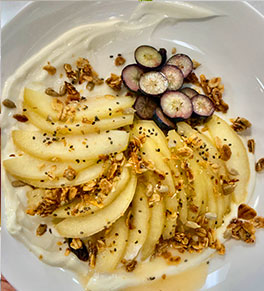Steaming and poaching: A healthier way to cook

Steaming and poaching are often overlooked as cooking techniques, rather like wallflowers at a lively party. But both methods are so easy and yield such tender, delicious results, it's well worth adding them to your repertoire. Best of all, cooking with moist heat preserves more nutrients than boiling, frying, roasting and even grilling.
“Steaming and poaching are excellent options for cooking lighter meals that are rich in nutrients and low in unhealthy fats,” says Katie Rankell, a registered dietitian and program director of the UCI Health Weight Management Program.
Steaming cooks food with heated water vapors, which prevents the loss of water-soluble vitamins B and C. Since steaming requires little to no added fat, it reduces the overall calorie count, making it ideal for maintaining or losing weight.
This gentle process also is particularly good at intensifying the natural flavors, textures and colors of vegetables, fish and many other foods.
Poaching, by contrast, involves submerging food in gently simmering water or broth. This method is especially beneficial for delicate proteins such as eggs, fish and poultry, as well as some fruit.
Like steaming, poaching preserves nutrients and natural juices and flavors, enhancing the food's overall taste without the need for heavy seasonings or sauces. It also allows it to cook evenly and thoroughly without becoming dry.
Savor these simple yet elegant recipes created by Jessica VanRoo, executive chef of the Susan Samueli Integrative Health Institute, part of UCI Health.
Steamed fish with scallions and ginger
 Lunar new year is right around the corner — the year of the wood snake in the Chinese horoscope — signifying a time of growth, introspection and transformation.
Lunar new year is right around the corner — the year of the wood snake in the Chinese horoscope — signifying a time of growth, introspection and transformation.
This classic recipe for Chinese-style steamed fish with scallions and ginger can be part of your celebration! Usually served as a whole fish, this dish is extremely popular at this time of year.
“Steaming gives fish a light almost fluffy texture and with minimal added oil and salt, it is far healthier than deep-fried or battered fish,” says Rankell.
“Pair it with seasonal steamed vegetables and a whole grain like quinoa and you have a fiber- and protein-rich meal.”
Jump to recipe ›
Fish is not only a source of lean protein, it is also full of omega-3 fatty acids that are known to decrease inflammation and play an essential role in brain and heart health. That's why experts recommend eating two to three servings of fish per week.
The ginger and scallions in this recipe also have anti-inflammatory properties. Scallions are rich in vitamin C, quercetin and lutein, all powerful antioxidants that protect cells from damage, reducing the risk of chronic diseases such as cancer and heart disease.
Gingerol is the bioactive compound that gives ginger its name and its healing powers. It is valued in both traditional and integrative medicine for its ability to reduce nausea, aid digestion and help fight viruses like influenza and the common cold.
Yu, the Chinese word for fish, also means "surplus," so this dish is sure to bring you health and prosperity in the coming year!
Poached pears with cinnamon, honey, Greek yogurt and granola
 Pears are a versatile, nutritious fruit that are great for maintaining long-term health.
Pears are a versatile, nutritious fruit that are great for maintaining long-term health.
They are a rich source of soluble fiber, which promotes digestive health by helping to regulate bowel movements and prevent constipation. Their high fiber content also supports weight management because they help you feel full longer, reducing the likelihood of cravings and overeating.
This luscious fruit is also low in calories and contains no cholesterol, making it a heart-healthy choice. Pears also are rich in antioxidants such as vitamin C and flavonoids, which support overall immune function and protect the body from oxidative stress and inflammation.
Consuming pears regularly may also help reduce the risk of chronic conditions like cardiovascular disease and type 2 diabetes.
Jump to recipe ›
The cinnamon in this recipe contains the compound cinnamaldehyde, giving the popular spice its own antioxidant potency by helping to fight inflammation and lower blood cholesterol and triglycerides. Cinnamon also has been show to help steady blood sugar levels.
Studies show that even small amounts of cinnamon can lower fasting blood sugar by 10% to 29% in patients with diabetes. The effective daily dose of cinnamon is typically a ½ teaspoon to 2 teaspoons.
Honey is another health booster in this recipe. A natural sweetener with a lower glycemic index, honey is a healthier alternative to refined sugar. In addition, it has natural antimicrobial and anti-inflammatory properties that can soothe sore throats and promote wound healing.
Honey also supports digestive health, acting as a prebiotic to promote the growth of beneficial gut bacteria. It can help boost energy levels, improve skin health and even aid in the management of blood sugar levels when consumed in moderation.
“Pears are naturally very sweet tasting when ripe and pair well with cinnamon," Rankell says. "Poaching intensifies and melds their flavors.”
Enjoy this guilt-free treat that is perfect for breakfast, a snack or even dessert!




